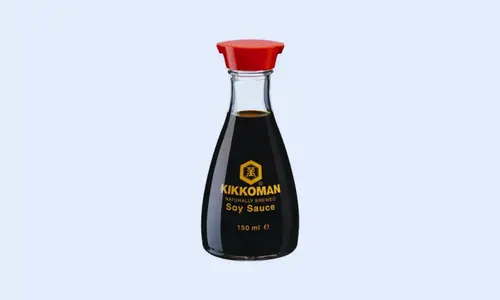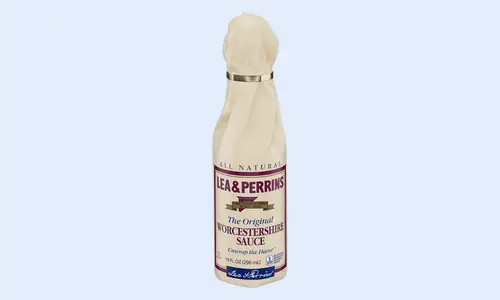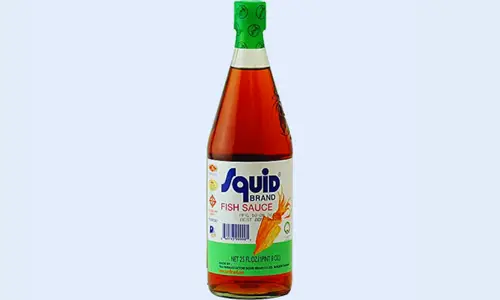Fish sauce is a staple in many Thai, Vietnamese, and Southeast Asian cuisines. It has a pungent smell and adds an earthy, umami flavor to any dish. Fish sauce is made from salted fish (typically anchovies) that have been fermented for several months or even years.
The longer the fermentation process, the less fishy the flavor. Instead, a long fermentation process results in a nutty, umami taste. There are three kinds of fish sauce: first press, second press, and third press. Now let’s get into our favorite substitutes for fish sauce when run out, or when we’re just looking to spice up a recipe.
Substitutes for Fish Sauce
[1] Soy Sauce + Rice Vinegar + Salt

Many people opt to substitute soy sauce and fish sauce at a 1:1 ratio but if you want your fish sauce substitute to have a flavor and smell as close to the original ingredient as possible, add rice vinegar and a pinch of salt to the mixture.
For example, if the dish calls for one tablespoon of fish sauce, use ½ tablespoon of soy sauce and ½ tablespoon of rice vinegar, throw in a pinch of salt and have a fish sauce substitute ready to use.
[2] Soy Sauce and Lime Juice
Adding lime juice to soy sauce can mimic the sourness of fish and add acidity that is common in Thai and Vietnamese dishes. Combine soy sauce at a 1:3 ratio with the lime juice.
Therefore, if your recipe calls for one tablespoon of fish sauce, mix one tablespoon of soy sauce with three tablespoons of lime juice. Measure out one tablespoon of the mixed liquid and use it as a substitute for one tablespoon of fish sauce.
[3] Soy Sauce + Anchovies
If your dish uses fish sauce to add a fishy flavor, you can finely dice anchovies and achieve a similar taste. For stir fry and pad thai dishes, you can mix the anchovies in on their own but if you are making a broth or soup, add soy sauce to your chopped anchovies to ensure you don’t change the consistency of the dish.
Anchovies are small, silvery fish that are part of the herring family. They have a distinctive flavor. You’ll find anchovies in many cuisines around the world, especially in Italian and Spanish dishes. Anchovies have a high amount of omega-3 fatty acids, which can help to prevent heart disease and stroke.
[4] Coconut Aminos + salt

Coconut aminos are harvested from the sap of the coconut flower, fermented to create a rich flavor, and often compared to soy sauce. Coconut aminos will not give a dish the salty taste that fish sauce will, so if your dish requires this flavor, opt for another substitute.
However, if you’re using the fish sauce to create a salty, umami flavor, you can use coconut aminos and a pinch of salt as a substitute.
Coconut aminos, sometimes referred to as coconut liquid aminos or coco aminos, are a dark, thin sauce made from the sap of the unopened coconut flower of the coconut palm tree.
It is combined with salt and left to ferment, resulting in a liquid that tastes similar to soy sauce with a deep umami flavor. Contrary to popular belief, coconut aminos do not taste like coconut but instead have a savory taste with a buttery aftertaste.
This ingredient is often used in dipping sauces and marinades. You will often find coconut aminos as an ingredient in health-conscious recipes as it is soy-free, gluten-free, dairy-free, and vegan friendly. Coconut aminos are also low-glycemic and contain 17 amino acids, so they’re ideal for weight loss.
[5] Worcestershire Sauce

Worcestershire sauce combines vinegar, fermented onions and garlic, molasses, tamarind, sugar, salt, cured anchovies, and various spices. It is a common condiment in most American households. It has a distinct, robust flavor, so you don’t need as much to mimic the taste of fish sauce. Start with a 0.5:1 ratio when substituting and taste before adding more.
Worcestershire sauce is a condiment made from fermented anchovies, vinegar, molasses, and spices. It’s a perfect blend of savory, salty, and sweet.
It’s commonly used as an ingredient in many different types of food, but it’s also great on its own. It has a rich, deep flavor that makes it the perfect addition to many different dishes.
Worcestershire sauce was originally created in Worcester, England by a man named Lea & Perrins back in 1837. They wanted to create something that would complement their sauce for meat and fish—something that could enhance the taste without being overpowering or overwhelming. They found success with their creation of Worcestershire sauce.
Three Quality Levels of Fish Sauce

First press fish sauce is the liquid that first comes out of the vat after fermentation. It is considered the highest quality fish sauce and can be used as a standalone dipping or finishing sauce. Second press fish sauce is made by adding salt water to the remaining liquid after the first press is retrieved and letting the remaining liquid sit for an additional 2-3 months.
Second press fish sauce is most commonly used to make marinades. Finally, third press fish sauce is considered the lowest quality and is used in stir-fries, fried rice, and pho dishes.
FAQ
What can I use in a recipe instead of fish sauce?
If you do not have fish sauce on hand or are looking for a vegan or vegetarian option for your recipe, you can use soy sauce mixed with rice vinegar and salt, soy sauce mixed with lime juice, or soy sauce and anchovies to mimic the taste of fish sauce. You can also use coconut aminos and salt or Worcestershire sauce as a substitute for fish sauce.
Can you substitute Worcestershire sauce for fish sauce?
Worcestershire sauce has a similar zesty, smoky flavor and is a common substitute for fish sauce. Worcestershire sauce is lower in sodium and has a thicker consistency, so you may need to add salt and water to the sauce to make it comparable to fish sauce.
Can I use hoisin sauce instead of fish sauce?
Hoisin sauce is made from fermented soybeans and, like Worcestershire sauce, is a slightly thicker consistency than traditional fish sauce and has a sweeter flavor. Therefore, you will want to add soy sauce to the hoisin sauce to offset the sweetness of the hoisin sauce and create a similar consistency to fish sauce.